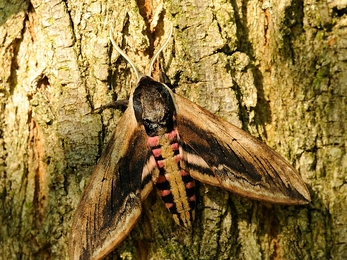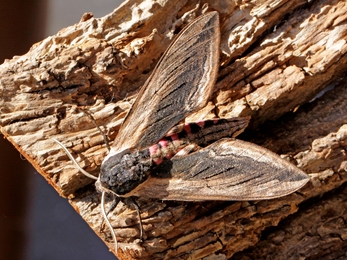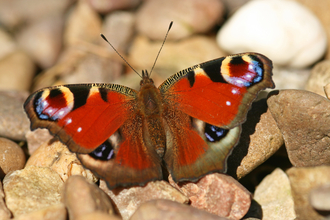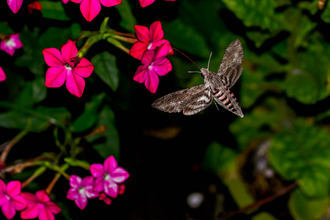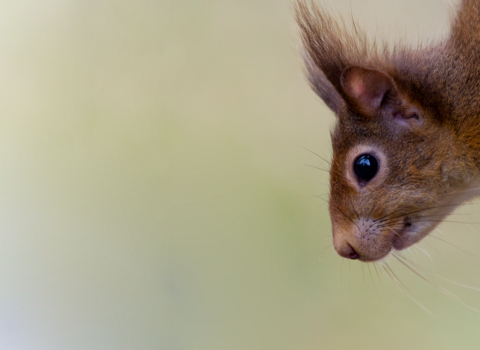What moth have I found?
With around 2,500 species of moth in the UK, there's an amazing amount of diversity to be discovered! Moths don't just come out at night. Some species fly during the day, especially on warm and sunny days. There are actually very few differences between moths and butterflies and they all belong to one group - Lepidoptera.
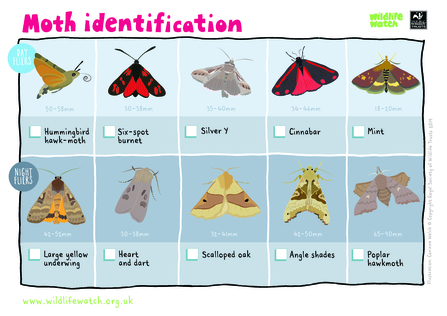
Jersey tiger
Description: The black forewings have striking creamy-white stripes and the hindwings are bright red, yellow or orange. Flies on warm days.
When & where: July-September. A range of habitats including rough ground, coastal cliffs and gardens. On the south coast of England, but rapidly spreading north, with a strong London population.
Read more
Six-spot burnet
Description: Black with slender wings. Each forewing has six red spots (the two closest to the head often look like one red smudge). Flies in the day, visiting flowers like a butterfly.
When & where: June-August. Flowery grassland throughout the UK. Caterpillars feed on bird's-foot trefoil.
Scarlet tiger
Description: Has iridescent black forewings with white and yellow spots, and red hindwings with black markings. Flies during the day.
When & where: June-July. Favours damp habitats like riverbanks and fens, but sometimes visits gardens. Most common in the south-west of England and Wales.
Silver y
Description: Brown with a metallic silver y-shaped mark on each forewing. One of the most commonly seen day-flying moths, easily disturbed from vegetation and often seen flying frantically as it feeds on flowers.
When & where: Mostly May-September, but can be seen in other months. An immigrant that is sometimes found in large numbers on the coast, but can be seen almost anywhere, including gardens.
Swallow-tailed moth
Description: An elegant pale yellow moth, easily identified by the pointed tail on each hindwing. Flies from dusk and is attracted to light.
When & where: June-August. Sometimes second generation September-October. Widespread in most of UK. Found in a variety of habitats including parks and gardens.
Brimstone moth
Description: A bright yellow moth with a chestnut line along the leading edge of each forewing, a mark at the tip, and a brown-edged white dash. Sometimes disturbed from vegetation in the day, flies just before dusk and comes to light at night.
When & where: April-October. Common across most of the UK. In woodland, scrub, hedgerows and gardens.
Read more
Green carpet
Description: A broad-winged, green moth with dark blotches and wavy, white lines across the wings. Flies at dusk and is easily disturbed from vegetation during the day.
When & where: May-September. Common across the UK, in most habitats including parks and gardens.
Large emerald
Description: A large green moth with wavy white lines across the wings. The wings have wavy edges. When resting, the wings are spread and raised slightly like a butterfly. Flies at night and is attracted to lights.
When & where: June-August. Common across the UK, in many habitats including woodland, scrubby grassland, parks and gardens.
Burnet companion
Description: A brownish moth with wavy crosslines on the forewings and orange-yellow on the hindwings. Flies on warm days, often with other species of moth and dingy skipper butterflies.
When & where: May-July. Common and widespread in southern England. Found on flowery grasslands, including meadows, verges and woodland.
Angle shades
Description: A distinctive moth that rests with its wings creased. Olive green with pink-brown arrow-shaped markings. Often seen resting on vegetation, walls and fences in the day.
When & where: Mainly May-October. Throughout the UK, in most habitats including parks and gardens.
Read more
Privet hawk-moth
Description: A large moth with a wingspan up to 12cm, blackish thorax and pink and black banded abdomen. Forewings are brown and hindwings are pink and black. Feeds on flowers at night and comes to light.
When & where: June-July. Common in southern England and south-west Wales, more scattered further north. A variety of habitats including gardens and hedgerows.
Large yellow underwing
Description: A large, variable moth. The long, rounded forewing has a distinctive black mark on the leading edge, near the tip. The hindwings are bright yellow with a black band. Often comes to light.
When & where: June-October. Found almost anywhere, but most commonly in open grassy areas.
Hummingbird hawk-moth
Description: The forewings and chunky body are grey-brown, with orange hindwings. Flits from flower to flower, hovering to feed like a hummingbird.
When & where: Mostly April-September, but can be seen in other months. An immigrant from southern Europe and north Africa. Most common on south coast but can turn up almost anywhere.
Herald
Description: Brown with white crosslines, orange blotches and scalloped wings. Adults hibernate over winter and are sometimes found in outbuildings or caves.
When & where: August-November and March-June after hibernation. Throughout the UK, in woodland, parks, gardens and other places the food plants are found such as willows and poplars.
Mint
Description: A small moth that has dark purple forewings with orange markings. The markings can be quite variable, but the most consistent one is a large orange blotch, sometimes with smaller orange spots speckled around it. The hindwings are dark with a short golden band that rarely reaches the edges of the wing.
When & where: Adults fly in two generations - one from April to June, a second from July to September. Found throughout England, Wales, and southern Scotland and the Inner Hebrides.

Chimney sweeper © Rachel Scopes

























